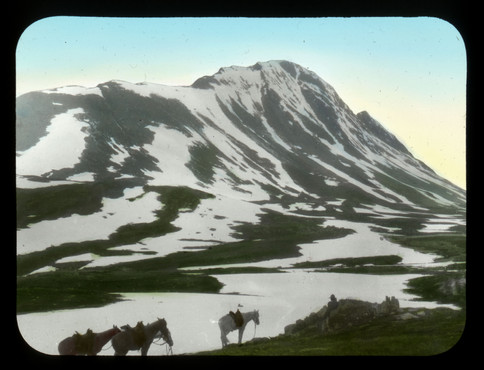By Kayla Cazes, Community Engagement and Reference Service Associate

Early Chalet at Lake Louise, [ca. 1883 – 1912], Trueman & Caple/photographer, WMCR, Mary Schäffer fonds (V527/PS/1/243)
Walter Wilcox describes in his book, The Rockies of Canada, the firsthand grandeur of the Canadian Rockies in the late nineteenth and early twentieth centuries. From the diversity of plants to the towering landscapes seen from new perspectives. First visiting Lake Louise in 1893, Wilcox writes that, “Lake Louise [had] the enduring attraction of nature in one of her grandest and most inspiring moods.”[1] Camping along the shore of the lake, Wilcox continued to describe the area including the “discovery” of Paradise Valley and the coming of tourists to the lake, including their continuous destruction of wildflowers.

Walter D. Wilcox, ca. 1896, WMCR, Bill Peyto fonds (V497/11/NA66/469)
Born in 1869 in Chicago, Illinois, Wilcox grew into a well-rounded man, who attended Andover, Yale, and later Columbia Universities. The allure of the wild plagued him from a young man onwards, surmounting in the ascent of Mount Hood and the first ascent of Eagle Peak in the Selkirks. He made numerous first ascents during his time in the Canadian Rockies including Mount Aberdeen, Mount Temple, Observation Peak, and Mount Niblock. During this period, he was also known for being the first white man to reach Fortress Lake through what is now known as Wilcox Pass from the Icefields Parkway.
Image 1: [Packtrain on Wilcox Pass], [1907], Mary Schäffer/photographer, WMCR, Moore family fonds (V439/PS-16). Image 2: Fortress Lake, 1907, WMCR, Mary Schäffer fonds (V527/PS/1/21)

North Face of Mount Temple from Paradise Valley, [1907?], Elliot Barnes/Photographer, WMCR, Elliot Barnes fonds (V48/NA-406)
In August of 1894, Wilcox, Samuel E. S. Allen, and Lewis Frissell successfully climbed Mount Temple (3,544 metres/11,627 feet), making them the first to stand upon the mountain’s summit. Wilcox describes this experience in multiple publications but the main highlight is the emphasis on the importance of teamwork and persistence in mountaineering.

Bill Peyto and his shack, August 1913, A. Knechtel/photographer, WMCR, Bill Peyto fonds (V497/201/NA66/262)
Through his adventures he became acquainted with Banff locals and other mountaineers alike. Some mentionable encounters include Tom Wilson, Bill Peyto, Philip Stanley Abbot, and Edward Feuz Sr. These encounters which are described in his book, The Rockies of Canada, details quaint descriptions of their personalities and actions during trips.

Wilson packtrail on Banff Avenue, left to right: L. J. Steele, Ross Peacock, Bob Campbell, Walter Garrett, and Walter Wilcox, 1899, A. B. Thom/photographer, WMCR, William Whyte family fonds (V715/2/NA66/487)

Lake Louise, [ca. 1900 – 1929], WMCR, Mary Schäffer fonds (V527/PS/1/286)
His observations of the scenes he witnessed were particularly poetic but also form a solid connection with current sceneries we witness today. His description of Lake Louise after a severe rain “…It [was] impossible to tell or paint the beautiful colours, the kaleidoscopic change of light and shade,”[2] could have been written yesterday.

Larches covered in snow, Larch Valley, Moraine Lake, September 2018, Kayla Cazes/photographer
Furthermore, his description of the larch is quite detailed, “In October the larch needles fade, and during autumn mark a band of pale yellow on mountains. The Lyall’s larch is a constant source of delight to the mountaineer, and adds much beauty to those higher valleys and slopes where the deep forests end and the perpetual snows first appear. Its rough bark and crooked branches, adorned with a scanty foliage, make a light shade and show the blue sky beyond. In such places, contrasted with the cliffs and snow fields of the mountains, it lends a charm to their grandeur.”[3]

Trail Riders at the Lake of the Hanging Glaciers in the Selkirk [Purcell] Mountains [B.C.], 1928, WMCR, John Murray Gibbons fonds (V226/LC/ACCN/3604/NA66-2402)
A fellow of the Royal Geographic Society, Wilcox had been a National Geographic Society delegate to the Geographical Congress of the Paris Exposition in 1900. He was also a past president of Trail Riders of the Canadian Rockies, member of the Appalachian Mountain Club and an Honorary Member of the Alpine Club of Canada. He died in July of 1949 at the age of 79 years old.

Did you know that all of the photographs used in this article are available for purchase? By searching our database archives.whyte.org you can find unique images for your home or commercial use!
If you would like to learn more about a particular topic, please reach out to us at archives [at] whyte.org with your inquiry. We are happy to help!
Notes:
1. Wilcox, Dwight Walter. The Rockies of Canada: a revised and enlarged edition of Camping in the Canadian Rockies (New York, U.S.A.: G. P. Putnam’s Sons, 1909), 14.
2. Wilcox, The Rockies of Canada, 25.
3. Wilcox, The Rockies of Canada, 65.




